Operations
Operations
Bomber Command Prepares for D-Day
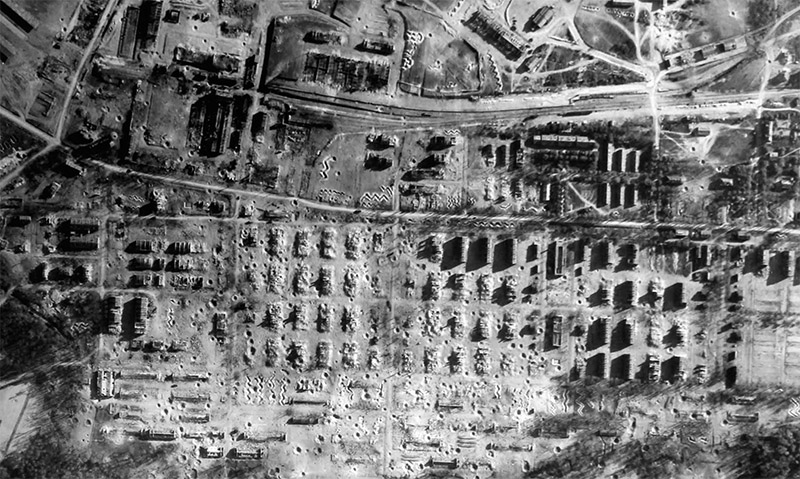
Rail Targets
1944 was surely the turning point of World War II in Europe. In Italy, the Allied advance had finally fought through auxiliary German defensive lines to reach the Gustav Line, the backbone of the Winter Line defences. In doing so the scene was set for the four battles of Monte Cassino which took place between January and May 1944.
The Russian Army was now on the offensive in the East, exerting relentless pressure. Having surrounded German positions at Stalingrad, they liberated Leningrad on January 27 after 872 days of siege.
And in the air, the combined Allied bomber force began to overwhelm the Germans. The RAF’s capacity continued to grow as production of Lancaster and Mosquito continued at speed. And American escort fighters could now give effective protection to daytime raids.
Conflicting Strategic Priorities
With preparations for the invasion of Europe well underway (Operation Overlord), Allied planners sought to identify suitable objectives for the heavy bomber force to support the liberating forces. Potential targets included the German air force (Luftwaffe) in the west, particularly its fighter aircraft, the rail transport network along which German reinforcements would have to pass, and the enemy’s defences on the shores of ‘Fortress Europe.’ It was also surmised that later, with the troops ashore, the bombers could then be called upon by army commanders for use against battlefield objectives.
None of this found favour with Air Chief Marshal Sir Arthur Harris, in charge of RAF Bomber Command. Harris had his own view on what his bombers should be doing, namely ‘area attacks’ on German industrial cities, and continuing the series of sustained strategic attacks begun in 1943 against the Ruhr, Hamburg and Berlin in 1943.
In his opinion only the systematic degrading of Germany’s entire industrial fabric could achieve decisive results and assist the invasion. Any cessation of attacks would allow German output to recover. Moreover, he believed that his force, trained to operate at night and unable to hit pinpoint targets, would be of little use against tactical targets, and might cause catastrophic casualties among French civilians.
Lieutenant-General Carl Spaatz, in charge of the American strategic bomber forces in Europe, also thought it vital that the pressure be maintained on Germany. He remained keen to target Germany’s oil industry and fuel supplies which he saw as the best way to cripple Hitler’s forces.
As well, concerns were raised over bombing occupied countries rather than Germany itself. Winston Churchill was one of those still worried about loss of life and he would insist that locations where more than 150 French or Belgian casualties might be expected from a single raid be excluded from bomber operations.
But Overlord was too important to let such dissent persist. On 14 April 1944 both RAF Bomber Command and the US Strategic Air Forces in Europe were formally placed under the direction of General Dwight D Eisenhower and Supreme Headquarters Allied Expeditionary Force (SHAEF).
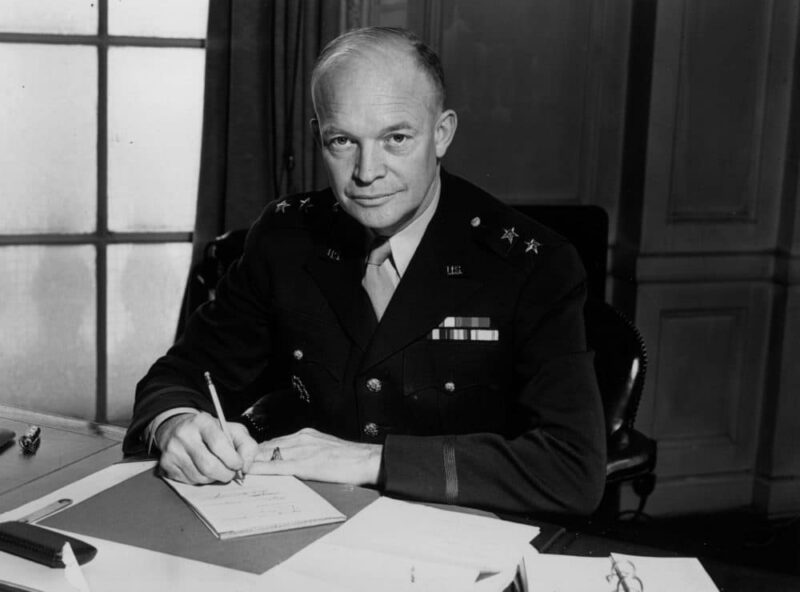
The Commander of American Forces in the European Theatre, Major General Dwight Eisenhower
(Photo by M. McNeill/Fox Photos/Getty Images)
Attention turns to France
On 17 April 1944, the Allied Supreme Headquarters issued a directive to Harris and Spatz which stated the primary mission of the heavy bombers prior to Overlord was the destruction of the Luftwaffe’s air combat strength and the disruption of rail communications to isolate the designated invasion area in Normandy.
Harris and Spaatz were given allowance to continue attacks on German targets only if and when commitments to Overlord and the weather permitted.
Despite his opposition Harris was already carrying out attacks on rail targets, to test the feasibility of the ‘Transportation Plan.’ The first was against the Trappes railway yards on the outskirts of Paris on the night of 6/7 March. In the same month, his bombers hit similar targets at Le Mans and Amiens. The results augured well, as RAF losses were light and Harris’s fears over accuracy were misplaced.
New target marking techniques ensured that his crews were able to deliver their bombs with greater precision than expected. From the first five operations French casualties numbered approximately 110. Allied leaders were encouraged, and the bombing stepped up, with the Americans now joining in too.
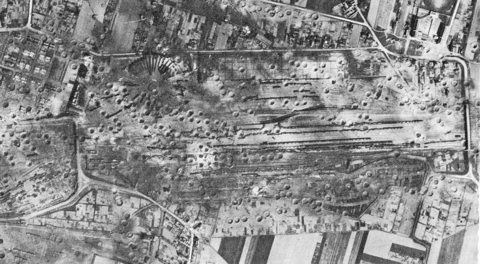
An example of bombing rail targets – photographic-reconnaissance showing severe damage to the St Pierre des Corps marshalling yards at Tours, France, after the raid by 180 Avro Lancasters of No. 5 Group, Bomber Command, on the night of 10/11 April 1944.
(Credit Imperial War Museum)
In all, RAF and USAAF bombers carried out operations against 72 separate rail centres in France, Belgium and western Germany before D-Day – locomotive depots, repair facilities and marshalling yards. The 37 assigned to Harris’s force were all destroyed or seriously damaged.
Large numbers of locomotives were wrecked, and wagon numbers reduced from 70,000 to 10,000. When combined with attacks carried out by tactical aircraft on bridges and local lines, it meant that German reinforcements, especially the panzer divisions which were heavily dependent on rail transport, would have a much harder job reaching the front once the Allies were ashore.
Bomber Command’s night attacks proved more accurate than American daylight strikes – a fact Harris was keen to trumpet. The rail yards at Juvisy and La Chapelle near Paris were completely destroyed after single attacks on each, with minimal collateral damage.
A total of 198 RAF bombers were lost – considered an ‘acceptable’ rate of loss. Sadly, the civilian casualty rate in some cases far exceeded the prescribed limit of 100-150 each. At Lille on 9/10 April 456 civilians died and in Ghent on 10/11 April it was 428 killed.
Although the railway system was the priority in April and May 1944, there were also attacks on airfields and aircraft factories in France. Again, the accuracy of RAF night attacks was impressive. One spectacular success was a raid on an aircraft factory at Toulouse on 5/6 April, which was destroyed after aircraft of 617 Squadron carried out accurate low-level marking in advance of the main force of bombers.
Other targets were military depots and ammunition dumps. A raid on a military depot at Mailly-le-Camp on 3/4 May destroyed many tanks and vehicles, although German night-although fighters shot down 42 RAF bombers (see below).
Minelaying operations continued too. This had always been an important but unsung part of Bomber Command’s work, and in the run-up to D-Day 2,198 sorties were flown to sow mines in enemy waters either side of the invasion corridor, and at the mouths of harbours sheltering German motor-torpedo boats (E-boats) and submarines.
The bombing campaign was supported by Allied fighter squadrons who flew systematic and debilitating attacks on German fighter airfields and planes on the ground in France, as well as waging battle in the air.
RAF fighters destroyed nearly two thousand enemy aircraft over the English Channel and surrounding countryside. This, combined with the fact that the bulk of the Luftwaffe was busy on the eastern front fighting the Soviet air force, meant that by D-Day the Allies had supremacy in the skies around England and the French coast.
New Zealanders on Ops ahead of D-Day
As Bomber Command began attacking pre-invasion routes in Northwest Europe, there is little doubt that crews welcomed the shorter raids to France and Belgium.
But we should not underestimate the risks they still faced. Raids on Chambly and Mailly-le-Camp in May highlight this.
Chambly
On the night of 1-2 May, eight hundred bombers were sent on a total of fourteen separate missions. One of the most important was the raid on Chambly, a key point on the rail system. Two New Zealanders died in one of three Lancasters lost on that operation.
Having flown 15 Ops with 75 (NZ) Sq., Alan Speirs and his crew including fellow kiwis, navigator Jack Wain and rear gunner Johnny Clift had volunteered for pathfinders, joining No.7 Sq. Theirs is a story of fate. Dressed up and ready for leave, they were called back and put on ops as the squadron was short of numbers that night.
Having successfully marked Chambly and turned away “all hell broke loose” Suddenly their aircraft was a flying bonfire. There was nothing anyone could do “I just told the crew to get out and get out fast,” said Speirs. He had an attached seat-type chute, the others had to grab their chutes and clip them on.
“My next recollection is hanging by my seat harness and from my waist up I was outside the aircraft. The Lancaster was upside down and I was hanging from it. There was no longer anything I could do except release my seat harness. I just fell out and that was that.”
Having survived the fall, Spiers was found by the resistance and was helped to evade, returning to London in August. Sadly, no one else got out of the flaming aircraft, Wain and Clift along with the rest of the crew are buried near Chambly.
Mailly-le-Camp

Mailly-le-Camp, showing destruction of the German military base
(Credit: 460squadronraaf.com)
Two New Zealanders died on the Mailly-le-Camp raid on 3-4 May, described by author Max Lambert, in Night After Night, as a cock-up, something most crews on that raid would agree with. Wireless operator Vic Viggars recalled returning to 101 Sq. base at RAF Ludford Magna, found four of the squadron’s Lancs had not made it. Of all the men aboard just two survived.
Bomb aimer Eric Blake was on just his second mission with 44 Sq. when his Lancaster was shot down while homebound near Dreux. All the crew were killed.
Leslie Lisette, a pilot with 207 Sq. died holding his crippled, burning plane aloft long enough for his crew to bail out. He is buried in Chaintreaux.
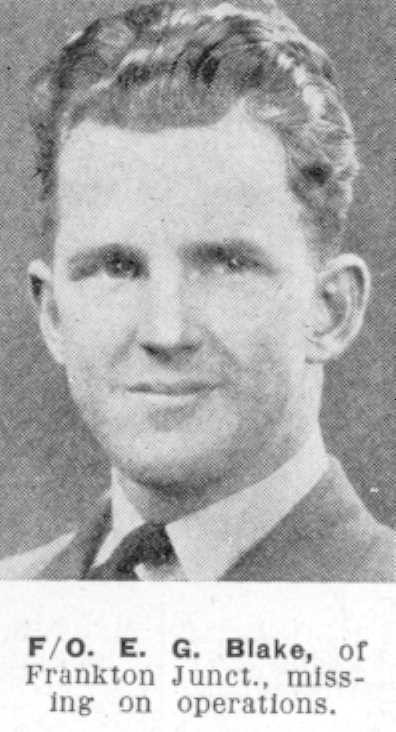
Eric Blake
(Credit: Online Cenotaph)
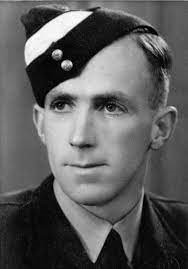
Leslie Lisette
(Credit: Online Cenotaph)